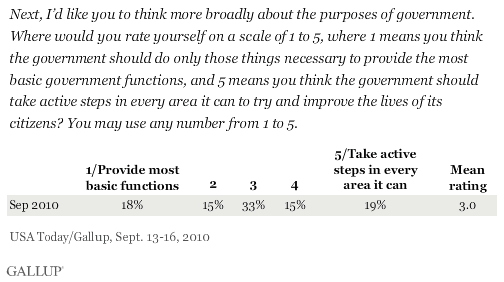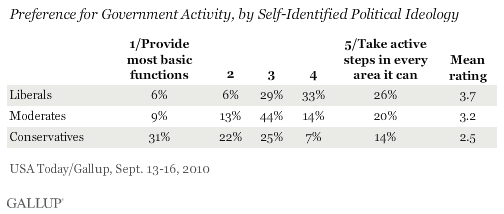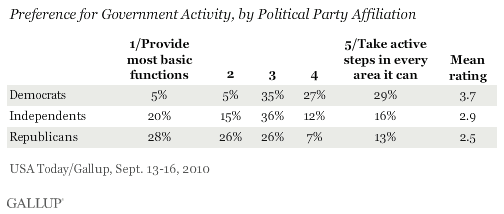PRINCETON, NJ -- Americans are essentially equally divided in their views of the role of the federal government, with one-third tilting toward a preference for a government that actively takes steps to improve the lives of its citizens, one-third preferring a limited government that performs mostly basic functions, and the remainder in the middle.

These results are based on a Sept. 13-16 USA Today/Gallup poll designed to help better understand what Americans want the federal government to do at a time of record- or near-record low levels of trust in the nation's political institutions and in the government's ability to deal with the problems facing the country.
The basic conclusion from the five-point scale question is that Americans are hardly unified in their views of what role they want the government to take, but rather array themselves about equally along a continuum ranging from very limited to very active government.
Thus, although Americans have generally negative top-of-mind reactions to the federal government as a brand or concept, the minority want government to limit itself to performing only a few basic functions.
Even among specific ideological and political groups the picture is hardly one of consensus and unity. Though conservatives tend to prefer limited government and liberals tend to prefer active government, among each group, slightly above 50% hold those views. In fact, about one in five conservatives indicate they want a fairly active government, and about one in eight liberals indicate they want a more limited one.
The plurality of moderates places themselves at the midpoint of the scale, with more tending toward active government than limited government.

The results are largely similar by political party, though independents tend more toward preferring limited rather than active government.

Bottom Line
While Americans have expressed concerns with the Obama administration's reliance on government to address the problems facing the country, they may be equally uncomfortable with the reaction against government that has emerged in the last two years, as embodied by the Tea Party movement. Rather, opinions are more nuanced. Americans don't necessarily hold a moderate view of how active government should be -- one-third pick the midpoint of a five-point scale -- but rather array themselves about equally along the continuum.
Thus, the answer of how active government should be may not be one that can be answered on a general, philosophical level, but may be decided on more of a case-by-case basis. Gallup will further explore the complex picture of what Americans want their government to do this week on Gallup.com.
Survey Methods
Results for this USA Today/Gallup poll are based on telephone interviews conducted Sept. 13-16, 2010, with a random sample of 1,019 adults, aged 18 and older, living in the continental U.S., selected using random-digit-dial sampling.
For results based on the total sample of national adults, one can say with 95% confidence that the maximum margin of sampling error is ±4 percentage points.
Interviews are conducted with respondents on landline telephones (for respondents with a landline telephone) and cellular phones (for respondents who are cell phone-only). Each sample includes a minimum quota of 150 cell phone-only respondents and 850 landline respondents, with additional minimum quotas among landline respondents for gender within region. Landline respondents are chosen at random within each household on the basis of which member had the most recent birthday.
Samples are weighted by gender, age, race, education, region, and phone lines. Demographic weighting targets are based on the March 2009 Current Population Survey figures for the aged 18 and older non-institutionalized population living in continental U.S. telephone households. All reported margins of sampling error include the computed design effects for weighting and sample design.
In addition to sampling error, question wording and practical difficulties in conducting surveys can introduce error or bias into the findings of public opinion polls.
View methodology, full question results, and trend data.
For more details on Gallup's polling methodology, visit https://www.gallup.com/.
